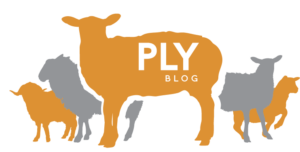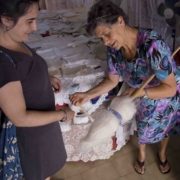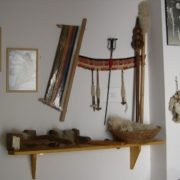When I dig through my stash, I am transported to vacations, friends’ homes, or even life events. I still have some of the (clean) fleece I scored on my honeymoon twenty-five years ago at The Big Sheep Farm and Theme Park in Devon, England. I have Portland yarn from the first rare breed fleece my husband bought me when we were dating. Fibery souvenirs help us relive special times long after the trips are over.
One of my first fleeces, acquired at age twelve from the Cornell University sheep barns, got tucked into my parents’ van under a seat on a family vacation in the Finger Lakes. There’s nothing like that raw wool odour in the family vehicle to endear you to your siblings on a long hot summer vacation.
Nearly every vacation is a chance to explore fiber arts. You can still dream about your holidays with these experiences long after the plane lands or you park the car in the driveway.
Plan ahead
Doing research ahead of time results in the best adventures. While the internet has lots of information, in some locations, the web hasn’t quite caught up with what you may hope to find.
For instance, if your goal is to come home with a particular breed of fleece or fiber, first locate a shop or farm that breeds that kind of sheep or animal. Then, reach out via whatever contact information you find to inquire about fleeces and pricing. Ask if you’re welcome to visit. Strangers aren’t usually welcome at someone’s rural farm without advance notice. Also bear in mind that farmers aren’t always sitting at their computer or smartphone while managing lambing or other farm chores.
Want to know what fiber arts adventures are in a place? Ask the locals. Search on Ravelry, ask on a local guild Facebook page, or call a local yarn shop or spinner who lives there.
Peruse magazines, podcasts, or online websites such as Modern Daily Knitting, which posts a series of knitting travelogues.
Years ago, I got many helpful tips on a listserv about what to see and do on the island of Crete. This went right down to the address of a yarn shop in Chania and what to look for at the Sitia Folk Museum. While all that was planned, meeting someone spindling to pass the time in her shop in Kritsa, also on the same trip, was an unexpected highlight. We shared no language but spindling.
Identify your interests and then check locations, hours, and entry fees, if there are any. It’s a bummer to arrive at a destination only to find it’s closed.
Create positive experiences for your travel mates
When planning adventures, remember your fellow travellers. Is there anything at these places that interests them? How long will you spend there? Is there another attraction or a place to have a coffee nearby?
Some spinners sadly complain that their partners weren’t willing to do fibre-related stops, but many companions know spinners’ interests and support them. However, it’s important to think of others’ needs, too. If your travel companions cannot manage any time spent at a yarn shop, folk art museum, or farm, look for alternate options for them. Limit the amount of time they must wait, or trade outings. Perhaps you can agree to spend time at the place they choose in exchange for an equal amount of time at your chosen destination.
If you have disabilities or small kids, there are places that may not work out. Some farms and museums are accessible and love to welcome everyone, including children. Other places remain off limits because they might be dangerous – or they just aren’t accessible or child-friendly.
Be open to a change in plans
Having flexibility while one travels can be helpful. If you schedule your outings with a tight time table, this can make unexpected adventures difficult to pull off. You might end up at a destination that isn’t open yet. Or you might require long bus rides or trains to get there. I once took a long local route bus across Guildford, England, to get to George Weil & Sons, an amazing spinning and weaving shop. It was a great experience, but the excursion took nearly all day. On the bus, I saw many school kids and grocery-buying pensioners.
What if you find a spinning wheel you have to buy in a junk or antique store? More than twenty years ago, my husband visited the Netherlands for a work-related conference. Colleagues loaned him a bike. He went to an outdoor market and found a second-hand Dutch spinning wheel. He purchased the wheel for a very small amount. His kind colleague helped transport the wheel, broken down into two pieces, on two bikes across town. When he returned from Europe, he reassembled his gift for me – a spinning wheel, bought on the fly.
Taking extra time at a Rare Breeds Park to find the farmer on the Isle of Wight was worth it. The farmer handed me a Hebridean fleece for only five pounds. He was thrilled I was interested.
Be flexible about how things get sent home
If you’re flying or crossing international borders, consider shipping home your new treasures if it won’t fit in your luggage. Be mindful of international customs and agriculture laws. Sheep diseases like hoof and mouth can travel on your boots from one country’s farm to another. Raw wool is not allowed across certain international borders. Figure out the regulations in advance. Do your best to abide by them. If shipping, ask at the local shipping agent about the regulations as they usually also know what is safe to ship.
Thank everyone
Gratitude is appreciated in every language. Saying thank you goes a long way no matter what or who you see, purchase, or meet. Museum docents, shopkeepers, and artisans on the street will treat you nicely if you show interest and good manners. Consider purchasing something, even if it’s small.
Keep notes, tag purchases, take photos, and journal
I thought I’d remember every single handspun skein and fleece acquisition. Alas, even good memories can fade over time. Document your finds. Label things, write notes to tuck in each bag, take photos (and maybe post on social media), or journal. A precious item can feel special again years later when these memories surface. Otherwise, you may come across an unmarked white skein of handspun or a wrinkled tag from a long lost farm. You’ll have no idea where it came from. To preserve your finds, give “future you” and your family a fighting chance.
Here’s to new learning and fiber arts adventures! Safe travels – and embrace all those fibery opportunities!
 Joanne Seiff has written three fiber-related books: Three Ply, Fiber Gathering, and Knit Green. She writes, edits, spins, knits, and designs in Winnipeg. See her designs on Payhip, Ravelry, and Lovecrafts.com – her designs might sing in your handspun. Read joanneseiff.blogspot.com or @yrnspinner on Instagram to learn more!
Joanne Seiff has written three fiber-related books: Three Ply, Fiber Gathering, and Knit Green. She writes, edits, spins, knits, and designs in Winnipeg. See her designs on Payhip, Ravelry, and Lovecrafts.com – her designs might sing in your handspun. Read joanneseiff.blogspot.com or @yrnspinner on Instagram to learn more!






Leave a Reply
Want to join the discussion?Feel free to contribute!